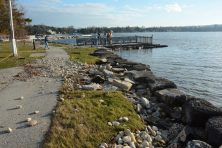Managing Shorelines along Green Bay and Lake Michigan
- Share
- Tweet
- Pin
- Share
Lakefront property owners battling exposed beach, shorelines and wetlands due to low water levels of Lake Michigan and Green Bay can find land management advice to protect wildlife habitat and water quality from the Department of Natural Resources (DNR).
DNR Water Management Specialist Carrie Webb says most activities conducted on the exposed lakebed – including beach-grooming, cutting and chemically treating vegetation – require a permit from the agency.
“Most of the exposed areas are below what is called the ‘ordinary high water mark,’ which is the dividing line between private property and the publicly owned lake bed,” Webb said.
These activities require a DNR permit: cutting an area larger than 30 feet wide; driving a motor vehicle on the lake bed; tilling; and, chemically treating vegetation if the area is wet. Permits are required to ensure the activity does not damage the lake or the exposed habitat.
Webb encouraged lakefront property owners to find out if permits are required since penalties for acting without a permit can total $186 for driving on an exposed lake bed and $1,318 for illegal dredging, which includes activities such as tilling and disking.
Some minor vegetation management and some activities done by hand do not require permits from the DNR, Webb said.
DNR Water Resources Specialist Mary Gansberg said of major concern to many property owners is the growth and spread of the invasive plant, phragmites, which can grow to a height of 12 feet while overpowering native plants and blocking lake views.
“We recommend property owners manage invasive species like phragmites to help maintain a diverse native plant community,” Gansberg said. “For property owners who have all phragmites on their beaches, they may cut that vegetation in an area greater than 30 feet by hand without a permit. Or, they may apply for a permit to use equipment to remove and control phragmites.”
For more information on lakefront property management and phragmites, visit http://dnr.wi.gov/org/water/fhp/waterway/.

